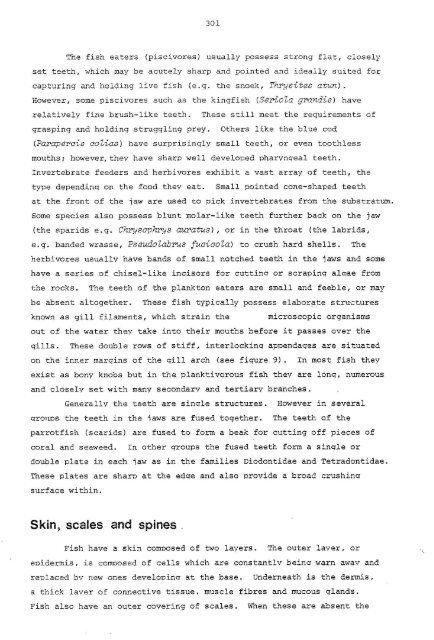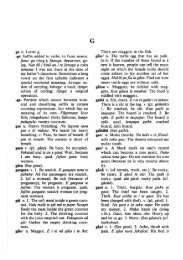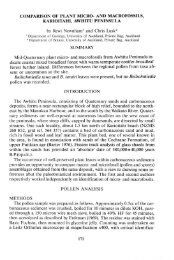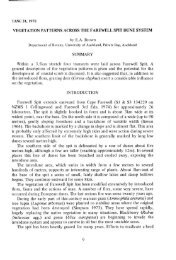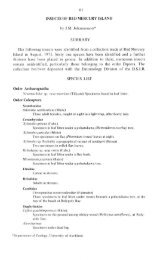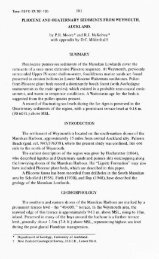aspects of fish biology form and function
aspects of fish biology form and function
aspects of fish biology form and function
You also want an ePaper? Increase the reach of your titles
YUMPU automatically turns print PDFs into web optimized ePapers that Google loves.
301a<br />
The <strong>fish</strong> eaters (piscivores) usually possess strong flat, closely<br />
set teeth, which may be acutely sharp <strong>and</strong> pointed <strong>and</strong> ideally suited for<br />
capturing <strong>and</strong> holding live <strong>fish</strong> (e.g. the snoek, Thrysites atun).<br />
However, some piscivores such as the king<strong>fish</strong> (Seriola gr<strong>and</strong>is) have<br />
relatively fine brush-like teeth. These still meet the requirements <strong>of</strong><br />
grasping <strong>and</strong> holding struggling prey. Others like the blue cod<br />
(Parapercis colias) have surprisingly small teeth, or even toothless<br />
mouths; however, thev have sharp well developed pharyngeal teeth.<br />
Invertebrate feeders <strong>and</strong> herbivores exhibit a vast array <strong>of</strong> teeth, the<br />
type dependinq on the food they eat. Small pointed cone-shaped teeth<br />
at the front <strong>of</strong> the jaw are used to pick invertebrates from the substratum.<br />
Some species also possess blunt molar-like teeth further back on the jaw<br />
(the sparids e.g. Chrysophrys auratus) , or in the throat (the labrids,<br />
e.g. b<strong>and</strong>ed wrasse, Pseudolabrus fucicola) to crush hard shells. The<br />
herbivores usually have b<strong>and</strong>s <strong>of</strong> small notched teeth in the jaws <strong>and</strong> some<br />
have a series <strong>of</strong> chisel-like incisors for cutting or scraping algae from<br />
the rocks. The teeth <strong>of</strong> the plankton eaters are small <strong>and</strong> feeble, or may<br />
be absent altogether. These <strong>fish</strong> typically possess elaborate structures<br />
known as gill filaments, which strain the microscopic organisms<br />
out <strong>of</strong> the water they take into their mouths before it passes over the<br />
gills. These double rows <strong>of</strong> stiff, interlocking appendages are situated<br />
on the inner marqins <strong>of</strong> the gill arch (see figure 9). In most <strong>fish</strong> they<br />
exist as bony knobs but in the planktivorous <strong>fish</strong> they are long, numerous<br />
<strong>and</strong> closely set with many secondary <strong>and</strong> tertiary branches.<br />
Generally the teeth are single structures. However in several<br />
groups, the teeth in the jaws are fused together. The teeth <strong>of</strong> the<br />
parrot<strong>fish</strong> (scarids) are fused to <strong>form</strong> a beak for cutting <strong>of</strong>f pieces <strong>of</strong><br />
coral <strong>and</strong> seaweed. In other groups the fused teeth <strong>form</strong> a single or<br />
double plate in each jaw as in the families Diodontidae <strong>and</strong> Tetradontidae.<br />
These plates are sharp at the edge <strong>and</strong> also provide a broad crushing<br />
surface within.<br />
Skin9 scales <strong>and</strong> spines .<br />
Fish have a skin composed <strong>of</strong> two layers. The outer layer, or<br />
epidermis, is composed <strong>of</strong> cells which are constantly being warn away <strong>and</strong><br />
replaced by new ones developing at the base. Underneath is the dermis,<br />
a thick laver <strong>of</strong> connective tissue, muscle fibres <strong>and</strong> mucous gl<strong>and</strong>s.<br />
Fish also have an outer covering <strong>of</strong> scales. When these are absent the


